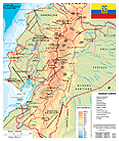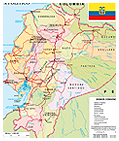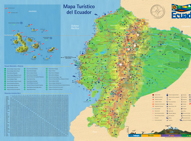
UNESCO
The following places in Ecuador are currently declared as UNESCO World Heritage Sites/Centres:
CULTURAL AND NATURAL HERITAGE
GALAPAGOS ISLANDS
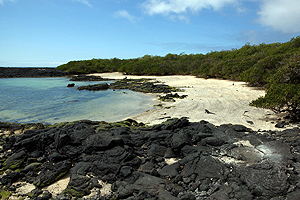 Registered in 1978, extended in 2001.
Registered in 1978, extended in 2001.
Located in the Pacific, about a thousand kilometres from the South American continent, these 19 volcanic islands and surrounding marine reserve are a museum and a living laboratory of evolution, unique in the world. The Galapagos are located at the confluence of three ocean currents and concentrate a wide variety of marine species. Its seismic and volcanic activity illustrates the process of its geological formation. These processes, together with the extreme isolation of the archipelago, has led to the development of unique wildlife species such as the land iguana, the giant tortoise and many species of finches, whose study inspired Darwin's Theory of Evolution by Natural Selection, after a trip to the islands in 1835 (UNESCO / BPI).
QUITO
 Cultural heritage registered in 1978.
Cultural heritage registered in 1978.
Founded in the 16th century on the ruins of an ancient Inca city perched 2850 meters above sea level, the capital of Ecuador has the best-preserved and least altered historic centre in Latin America, despite the earthquake that struck in 1917. Sumptuously decorated on the inside, the monasteries of San Francisco and Santo Domingo, as well as the church and school of the Compañía de Jesús (Society of Jesus), are perfect examples of the art of the Baroque school of Quito, in which Spanish, Italian, Moorish, Flemish and indigenous aesthetic influences merge (UNESCO / BPI).
SANGAY NATIONAL PARK
Natural heritage registered in 1983.
This park of outstanding natural beauty has two active volcanoes and a full range of ecosystems, from tropical rainforests to glaciers. Its landscapes offer striking contrasts between snow-capped peaks and flatland forests. Moreover, its isolation facilitates the protection of the endangered species that populate it, such as the mountain tapir and the Andean condor (UNESCO / BPI).
SANTA ANA RIVER BASIN (CUENCA)
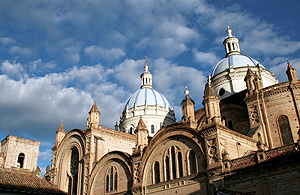 Cultural heritage registered in 1999.
Cultural heritage registered in 1999.
Santa Ana de los Ríos de Cuenca is nestled in a valley of the southern Andes of Ecuador. This colonial city, which is currently the third largest in the country, was founded in 1557, in accordance with the strict planning regulations promulgated thirty years earlier by Emperor Charles V. The urban layout of the city is still adjusting to the orthogonal plan established 400 years ago. Cuenca is now a regional agricultural and administrative centre, where the local population has mixed with successive generations of migrants. Most of the buildings date from the 18th century, but modernized urban architecture came with the economic prosperity that benefited the city in the 19th century when it became a major export hub for quinine, straw hats and other products (UNESCO / BPI).
INTANGIBLE HERITAGE
Presently, Ecuador has two elements registered on the list of Intangible
Oral heritage and cultural manifestations of the Zápara Peoples Intangible heritage registered in 2008 (originally proclaimed in 2001).
This information is shared with Peru
The Zápara live in a region of the Amazon rainforest located between Peru and Ecuador. Based in one of the world's richest biodiversity regions, they are the last representatives of an ethno-linguistic group that included many other populations, before the Spanish conquest. In the heart of the Amazon, they have developed an oral culture particularly rich in knowledge of the natural environment, as demonstrated by the abundance of their vocabulary for the flora and fauna, as well as their knowledge of medicinal plants in the forest. This cultural heritage is expressed through myths, rituals, artistic practices and language. This repository of knowledge and oral tradition constitutes the memory of the entire region.
Four centuries of history, marked by the Spanish conquest, slavery, epidemics, forced conversions, wars and deforestation have decimated these peoples. However, despite many threats, they have managed to preserve their ancestral knowledge. Through intermarriage with other Indigenous Peoples (Quechua and mestizo), they have survived. This dispersion, however, has also implied a loss of part of their identity.
The current situation of the Zápara is critical and does not exclude the risk of extinction. In 2001, the total number of Zápara was no more than 300 (200 in Peru and 100 in Ecuador), of which only five, now over 70 years of age, still speak the Zápara language (UNESCO / BPI).
Traditional Weaving of the Ecuadorian Panama Hat
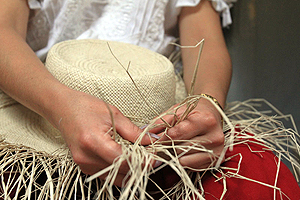 Intangible heritage registered in 2012.
Intangible heritage registered in 2012.
The Panama hat is woven with the fibres of a palm tree that grows particularly on the Ecuadorian coast. Coastal farmers cultivate toquillales and collect the stems in order to then separate the green bark fibre, boiling the latter to remove the chlorophyll and then drying it with charcoal and bleaching it with sulphur. The weavers use these raw materials to prepare the pattern, the cup and the brim of the hat. The fabric of a hat can last anywhere from one day to eight months, depending on quality and finesse. In the coastal community of Pile, weavers make superfine hats requiring specific climatic conditions and an exact number of points in each row of the weave. The preparation is finalized with a series of washing, bleaching, baking, ironing and pressing. The weavers are mostly peasant families and weaving techniques are transmitted to children at home, by observation and imitation, from a very early age. The techniques and skills encompass a complex and dynamic social fabric comprising, inter alia, the traditional techniques of cultivation and production, various forms of social organization and use of the hat as part of the everyday and festive attire. For communities that perpetuate this tradition of craftsmanship, it represents a hallmark of their identity and component of cultural heritage (UNESCO / BPI).
Text: www.unesco.org
History
Introduction
The first stage of Ecuador’s history dates back to the aboriginal societies of about 15,000 to 20,000 years BC. Those villages had their own social organization, beliefs, rituals and ceremonies, and an economy based mainly on agriculture and harvesting.
Vestiges of their existence can be found in different parts of the country, mainly in ceremonial centers and archaeological sites that have been discovered. Their existence lasted until the 16th century, when Spanish conquerors arrived. Scientists and scholars divided that stage into four periods: Paleoindian or Preceramic, Formative, Regional Development, Integration and Inca.
Pre-Columbian Period
| Year | Event | Details |
|---|---|---|
| 10000 - 3600 B.C. | Preceramic | The human being lived from hunting, fishing and gathering of fruits. |
| 3600 - 1800 B.C. | Early Formative | The human being lived from hunting, fishing, gathering of fruits and incipient agriculture. |
| 1800 - 1500 B.C. | Middle Formative | Agriculture further developed. |
| 1500 - 500 B.C. | Late Formative | Agriculture is strengthened. The economy becomes more agrarian. |
| 500 B.C. - 500 A.D. | Regional Development | Agriculture is further strengthened. Urbanization expands. |
| 500 - 1500 A.D. | Integration | Agriculture increases. Society becomes more complex. |
Period of the Incas
| Year | Event | Details |
|---|---|---|
| 1450 | Organization and expansion | Tupac Yupanqui began the conquest of the Andean north. |
| 1485 | Death of Tupac-Yupanqui | Huayna-Cápac is proclaimed an Inca. |
| 1525 | Death of Huayna-Cápac | Tahuantinsuyo, between Atahualpa and Huáscar, is divided. |
The Conquest
| Year | Event | Details |
|---|---|---|
| 1534 | Conquest of Quito | Sebastián de Benalcázar undertakes the Conquest of Quito. |
| 1563 | Audience of Quito | Philip II issues a royal decree, creating the Royal Audience and Chancellery of San Francisco of Quito. |
The Independence
| Year | Event | Details |
|---|---|---|
| 1809 - 1812 | Quito’s Revolution | Independence was declared without being obtained. |
| 1820 - 1822 | Independence: final stage | Patriotic forces finally manage to prevail. |
| 1822 | Gran Colombia: formation | With the name “District of the South”, Ecuador forms part of the Gran Colombia. |
| 1830 | Gran Colombia: dissolution | The independent State of Ecuador is formed: the life of the country as a Republic begins. |
Organization of the Incas (1000 AD)
The Central Andean Cordillera was the seat of the Incan Empire. In an area that exceeded four thousand square kilometers, it stretched from southern Colombia to northern Chile, over a territory called Tahuantinsuyo. The Incas consisted of a vast population of dozens of ethnic groups with different languages, customs and economies based on land use. In Ecuador, they expanded throughout the Andes, occupied parts of the coast and exerted considerable influence in Quito.
Arrival of the Spanish and end of Tahuantinsuyo (1532)
In 1532, the end of Tahuantinsuyo began with the incarceration of Atahualpa. Severe clashes took place between the Europeans and the Incas, who refused to be conquered. For the Spanish, America was a land full of riches, exploited in service to the Crown. Francisco Pizarro and Diego de Almagro were the main protagonists of the time and brutality dominated the local Indigenous Peoples. Several strategies were implemented by the Europeans, including the use of catechizing and of putting one rival Indigenous chief against another.
The Audience of Quito in the Colony
The Royal Audience of Quito was established in 1563 as an administrative entity dependent upon the Spanish Crown. It extended northwards to Pasto, Popayán, Cali, Buenaventura and Buga, in the current territory of Colombia, and southwards to Piura, Peru. Its first president was Spaniard Hernando de Santillán. From the beginning of the 18th century, the Audience of Quito was part of the Viceroyalty of Peru. It then passed to the command of the Viceroyalty of New Granada, located in Santa Fe, until its abolition, after which it once again became dependent on the Viceroyalty of Peru.
Political and Administrative Situation at the end of the 18th Century
Distrust was part of colonial society due to the ambiguous situation that unfolded in the Audience of Quito. The Marquis of Selva Alegre (1753) centralized the State and established a monopoly on alcohol and tobacco. Thus, the famous Tobacco Revolt occurred, which was joined by other uprisings of Indigenous Peoples. This was followed by administrative reorganizations that allowed for higher tax revenues. In the late 18th century, Francisco Luis Hector, Baron of Carondelet, became President and secured greater power for Quito, such as control over the Superintendent of the Royal Treasury and the creation of a Captaincy General.
Rupture with the Colony and Independence
Social decadence accelerated during the second half of the 18th century. Historians attribute several factors to the fall of the colonial system. One of these is considered to be the end of silver production in Potosí. The elaboration of textiles was notably reduced. The reforms that were introduced limited the power of the private elites. Independence occurred between the end of the 18th century and the first decades of the 19th century. Its causes were both internal and external in nature. One of these was the influence of the French Revolution on the region.
The Gran Colombia
After Independence, on different dates in 1822, the three most important cities in the country, Quito, Guayaquil and Cuenca, were incorporated into the Gran Colombia. Bolivar assumed the Presidency of this new nation consisting also of Venezuela and New Granada. With administrative organizational objectives, the territory was divided into the departments of Venezuela, Cundinamarca and Quito. However, the integration of these nations generated resistance and problems because of the emergence of particular interests and ambitions throughout the entire process, which all contributed to its disintegration.
Formation of the Republican State
Following the failure of Gran Colombia, the Republic of Ecuador was created in 1830. Since then, political struggles have characterized republican life. The new State did not accomplish the integration of its different regions. In this regard, local autonomous powers were formed that entered into conflict with the State and that, furthermore, handled their own resources. A unified currency did not exist, which seriously affected the existence of a central authority.
Text: Ministry of Tourism of Ecuador and the webpage of the Ministry of Foreign Affairs of Ecuador.
National Symbols
Flag
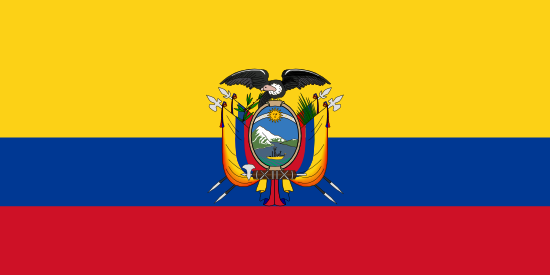 The inspiration for the design of the flag of the Republic of Ecuador was the pioneer of the well-known South American Independence, General Francisco de Miranda. The same design was later adopted by the Republics of Ecuador, Colombia and Venezuela. These three countries formed the confederation from 1822 until 1930, when each was converted into an independent nation. The flag continues to be the same for all three sovereign states, with only small differences distinguishing one from the other.
The inspiration for the design of the flag of the Republic of Ecuador was the pioneer of the well-known South American Independence, General Francisco de Miranda. The same design was later adopted by the Republics of Ecuador, Colombia and Venezuela. These three countries formed the confederation from 1822 until 1930, when each was converted into an independent nation. The flag continues to be the same for all three sovereign states, with only small differences distinguishing one from the other.
The flag of Ecuador has three horizontal stripes; from the bottom to the top, the colours are red, blue and yellow. The yellow stripe is two times wider than the red and blue stripes. The symbolism of the colours is the following: the red represents the blood shed by the soldiers and martyrs of the battles of Independence. The blue represents the colour of the ocean and the sky. The yellow symbolizes the abundance and fertility of the harvests and the land.
Coat of Arms
 It was then President of Ecuador, Eloy Alfaro Delgado, who formalized the elements that, until today, distinguish the State of the Republic of Ecuador, which are represented in the Coat of Arms:
It was then President of Ecuador, Eloy Alfaro Delgado, who formalized the elements that, until today, distinguish the State of the Republic of Ecuador, which are represented in the Coat of Arms:
- Condor: With outspread wings, lifted into flight position, it is a symbol of energy and effort.
- Laurel: Represents the nation’s glory.
- Oval: Its contour is double edged, colour brown, with the same colour joints, both above and below.
- Golden Sun: Signifies gold, important for the first settlers, which is found in the middle, with the signs of the zodiac.
- Signs of the Zodiac: To the left, Gemini and Cancer, to the right, Aries and Taurus, which represent March, April, May and June, months during which important events took place that reaffirmed the Ecuadorian nationality.
- Chimborazo: The highest volcano, its perpetual snow the source of the Guayas River.
- National flags: There are four, two on each side, front and rear, which coalesce under consular fasces.
- Palma: Represents the peace of the nation.
- Ribbon: Silk.
- Flagpoles: There are four and they crown each of the flags, which are inclined, with diamond, metal tips.
- Caduceus: Crowned by two wings and surrounded by two snakes, attribute of Mercury, it is a symbol of navigation and commerce.
- River Guayas: Gradually widens to fill the bottom of the oval. On the sides, there are lush green shores, an expression of national agriculture.
- Steam ship Guayas: In 1841, it was the first built in South America, in the shipyards of Guayaquil. The ship is a caduceus mast. The colours of the ship and its flag located in the bow are those of the national flag.
- Consular Fasces: Insignia of the Consuls of Rome, a symbol of authority and dignity.
- Axe: Large axe that formed part of one of the fasces of the Roman lictors (special class of civil servant).
National Anthem
The current national anthem of Ecuador, whose authors were the poet Juan León Mera Martínez (1832-1894) from Ambato and the musician of French origin Antonio Neumane Marno (1818-1871), was reformed a few times before reaching its final assessment and intangibility. It is also important to remember that there were other attempts to provide the country with a national anthem. For this reason, the people that appeared throughout the interesting history of our national symbol should be mentioned.
1830-1832: The Guayaquil-born singer Jose Joaquin de Olmedo writes a national anthem (a chorus and four stanzas) in honour of the nascent State of Ecuador. This creation, suggested by General Juan José Flores, was not achieved nor translated into music.
1833: A hymn by the name of Ecuadorian Song (six stanzas) was published in the Gazette of the Government of Ecuador No. 125 of 28 December. The paper refers to 1830 as the year of its creation, but most historians do not pay full attention to this, as it was written by an anonymous author.
1838: A national anthem (chorus and five stanzas) is included in the collection of General Flores’ poetry, published by the Government Printing Office, on his retirement from Elvira. In a later edition, there are changes to the third stanza. Still, for historians, it is the second known national anthem.
1865: The Argentine musician Juan José Allende, working with the Army of Ecuador, presents a draft of the musical version of Dr. José Joaquín de Olmedo’s lyrics to Congress, which was not widely accepted. In November, at the express request of the Senate President, Dr. Nicholas Espinosa, the then Senate Secretary, poet Juan León Mera Martínez, writes and delivers the national anthem, which was sent to Guayaquil in order for the master Antonio Neumane to write its musical accompaniment after being presented to Congress.
1866: On 16 January, the full version of Juan Leon Mera’s lyrics is published in Quito’s weekly newspaper “The South American”.
1913: The writer and diplomat from Guayaquil, Victor Manuel Rendon, delivers a new anthem with lyrics adapted to the music of Antonio Neumane; however, eventually the Legislature rejected the proposal.
1947-1948: Dr. José Miguel García Moreno, Minister of Education of the Carlos Julio Arosemena Tola Government, commissions the Jesuit priest Aurelio Espinosa Pólit and Juan León Mera Iturralde, son of the singer from Tunguragua, to study and collate the known versions. After careful study, commissioners finally recommend the issuance of a decree declaring that Ecuador’s national anthem be based upon the lyrics of Juan León Mera Martínez.
1948: On 29 September, the National Congress declares Juan León Mera Martínez’ verses as those of the official anthem. The Executive, then President Galo Plaza Lasso, enacted the Legislative Decree on 8 November and the lyrics were published in the Official Registry No. 68 from 23 November.
1965: Upon completion of the national anthem’s first centenary, the military junta that ruled the country proceeds to declare 26 November as the National Anthem Day of Ecuador. The decree was issued on 24 November.
1977: The Supreme Council of Government, by the decree of 11 March, provides for the deletion of certain repetitions in the national anthem, in order to make it shorter and easier for the general public to sing correctly.
From the 52 verses that make up the chorus and six stanzas, the parts of the anthem that are usually sung:
CORO
¡Salve, oh Patria, mil veces! ¡Oh Patria,
gloria a ti! Ya tu pecho rebosa
gozo y paz, y tu frente radiosa
más que el sol contemplamos lucir.
ESTROFA
Los primeros los hijos del suelo
que, soberbio, el Pichincha decora
te aclamaron por siempre señora
y vertieron su sangre por ti.
Dios miró y aceptó el holocausto,
y esa sangre fue germen fecundo
de otros héroes que atónito el mundo
vio en tu torno a millares surgir.
General information
- Official Name: Republic of Ecuador
- Surface Area: 256 370 km2
- Capital: Quito
- Form of Government: Democracy
- Main Cities: Quito, Guayaquil and Cuenca
- Language: Spanish
- Independence Day: 10 August
- Currency: US Dollar
- Religion: The dominant religion is Catholicism









